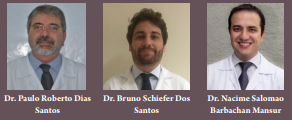Shockwave Therapy and Anesthesia: What Evidence is there?
Review Article | Volume 1 | Issue 1 | JRS December 2021 | Page 13-15 | Paulo Roberto Dias Santos, Bruno Schiefer Dos Santos, Nacime Salomao Barbachan Mansur DOI: 10.13107/jrs.2021.v01.i01.009
Author: Paulo Roberto Dias Santos [1], Bruno Schiefer Dos Santos [1], Nacime Salomao Barbachan Mansur [1,2]
[1] Departamento de Ortopedia e Traumatologia, Escola Paulista de Medicina, Universidade Federal de São Paulo, São Paulo, Brazil.
[2] Department of Orthopedics and Rehabilitation, Carver College of Medicine, University of Iowa, Iowa City, Iowa.
Address of Correspondence:
Dr. Nacime Salomao Barbachan Mansur, MD, PhD.
Departamento de Ortopedia e Traumatologia, Disciplina de Ortopedia e Traumatologia, Escola Paulista de Medicina – Universidade Federal de São Paulo, Brazil.
E-mail: nacime@uol.com.br
Abstract
Introduction: The use of anesthetics on extracorporeal shockwave therapy (ESWT) for musculoskeletal disorders is a matter of debate. Although widely performed, especially on focal procedures, its scientific background is sparse. This study aims to review the current evidence
on the use of anesthetics in ESWT.
Methods: A literature review of the PubMed, Web of Science, Embase, EBSCO, and Cochrane Library databases was performed. Studies assessing or comparing the use of any type of anesthetic in any form of shockwave therapy were collected.
Results: After inclusion and exclusion criteria assessment, a total of seven studies were found to directly address the subject and only four were original articles.
Conclusion: The produced evidence is small and lacks methodological quality. These facts support the necessity for new studies using the present technology to determine the real effect of anesthetics on ESWT.
Level of Evidence: Level V. Literature Review
Keywords: Shock waves, Radial pressure waves, Quality standards
Reference:
- Wang CJ. Extracorporeal shockwave therapy in musculoskeletal disorders. J Orthop Surg Res 2012;7:11.
- Moya D, Ramon S, Schaden W, Wang CJ, Guiloff L, Cheng JH. The role of extracorporeal shockwave treatment in musculoskeletal disorders. J Bone Joint Surg Am 2018;100:251-63.
- Schmitz C, Csaszar NB, Milz S, Schieker M, Maffulli N, Rompe JD, et al. Efficacy and safety of extracorporeal shock wave therapy for orthopedic conditions: A systematic review on studies listed in the PEDro database. Br Med Bull 2015;116:115-38.
- Korakakis V, Whiteley R, Tzavara A, Malliaropoulos N. The effectiveness of extracorporeal shockwave therapy in common lower limb conditions: A systematic review including quantification of patient-rated pain reduction. Br J Sports Med 2018;52:387-407..
- Schaden W, Thiele R, Kolpl C, Pusch M, Nissan A, Attinger CE, et al. Shock wave therapy for acute and chronic soft tissue wounds: A feasibility study. J Surg Res 2007;143:112.
- Barbachan Mansur NS, Matsunaga FT, Carrazzone OL, Dias dos Santos P, Schiefer Dos Santos B, Nunes CG, et al. Shockwave therapy plus eccentric exercises versus isolated eccentric exercises for achilles insertional tendinopathy: A double-blinded randomized clinical trial. J Bone Joint Surg Am 2021;103:1295-302.
- Schaden W, Mittermayr R, Haffner N, Smolen D, Gerdesmeyer L, Wang CJ. Extracorporeal shockwave therapy (ESWT)–first choice treatment of fracture non-unions? Int J Surg 2015;24:179-83.
- Valchanou VD, Michailov P. High energy shock waves in the treatment of delayed and nonunion of fractures. Int Orthop 1991;15:181-4.
- Treatment ISFMS. ISMST Guidelines. Italy: University of Florence; 2019.
- Rompe JD, Meurer A, Nafe B, Hofmann A, Gerdesmeyer L. Repetitive low-energy shock wave application without local anesthesia is more efficient than repetitive low-energy shock wave application with local anesthesia in the treatment of chronic plantar fasciitis. J Orthop Res 2005;23:931-41.
- Labek G, Auersperg V, Ziernhöld M, Poulios N, Böhler N. Influence of local anesthesia and energy level on the clinical outcome of extracorporeal shock wave-treatment of chronic plantar fasciitis. Z Orthop Ihre Grenzgeb 2005;143:240-6.
- Furia JP. High-energy extracorporeal shock wave therapy as a treatment for insertional Achilles tendinopathy. Am J Sports Med 2006;34:733-40.
- Klonschinski T, Ament SJ, Schlereth T, Rompe JD, Birklein F. Application of local anesthesia inhibits effects of low-energy extracorporeal shock wave treatment (ESWT) on nociceptors. Pain Med 2011;12:1532-7..
- Ramon S, Español A, Yebra M, Morillas JM, Unzurrunzaga R, Freitag K, et al. Current evidences in shockwave treatment. SETOC (spanish society of shockwave treatment) recommendations. Rehabilitacion (Madr) 2021;55:291-300.
- Schultheiss R. Stoßwellen-technologie in orthop¨adie undunfallchirurgie. In: Chaussy C, Eisenberger F, Jocham D, Wilbert D, editors. Die Stoßwelle. Forschung und Klinik. Germany: Attempto, Tubingen; 1995.
- Lohrer H, Nauck T, Korakakis V, Malliaropoulos N. Historical ESWT paradigms are overcome: A narrative review. Biomed Res Int 2016;2016:3850461.
- Maier M, Averbeck B, Milz S, Refior HJ, Schmitz C. Substance P and prostaglandin E2 release after shock wave application to the rabbit femur. Clin Orthop Relat Res 2003;406:237-45.
- Hausdorf J, Lemmens MA, Kaplan S, Marangoz C, Milz S, Odaci E, et al. Extracorporeal shockwave application to the distal femur of rabbits diminishes the number of neurons immunoreactive for substance P in dorsal root ganglia L5. Brain Res 2008;1207:96-101.
- Schmitz C, DePace R. Pain relief by extracorporeal shockwave therapy: An update on the current understanding. Urol Res 2009;37:231-4.
- Weber M, Birklein F, Neundorfer B, Schmelz M. Facilitated neurogenic inflammation in complex regional pain syndrome. Pain 2001;91:251-7.
- Hsieh ST, Lin WM. Modulation of keratinocyte proliferation by skin innervation. J Invest Dermatol 1999;113:579-86.
- Goto T, Yamaza T, Kido MA, Tanaka T. Light-and electron-microscopic study of the distribution of axons containing substance P and the localization of neurokinin-1 receptor in bone. Cell Tissue Res 1998;293:87-93.
- Brain SD, Williams TJ. Substance P regulates the vasodilator activity of calcitonin gene-related peptide. Nature 1988;335:73-5.
- Fischer AA. Pressure algometry over normal muscles. Standard values, validity and reproducibility of pressure threshold. Pain 1987;30:115-26.

| How to Cite this article: Santos PRD, Dos Santos BS, Mansur NSB | Shockwave therapy and anesthesia: What evidence is there? | Journal of Regenerative Science | December 2021;1(1):13-15. |

Leave a Reply
Want to join the discussion?Feel free to contribute!